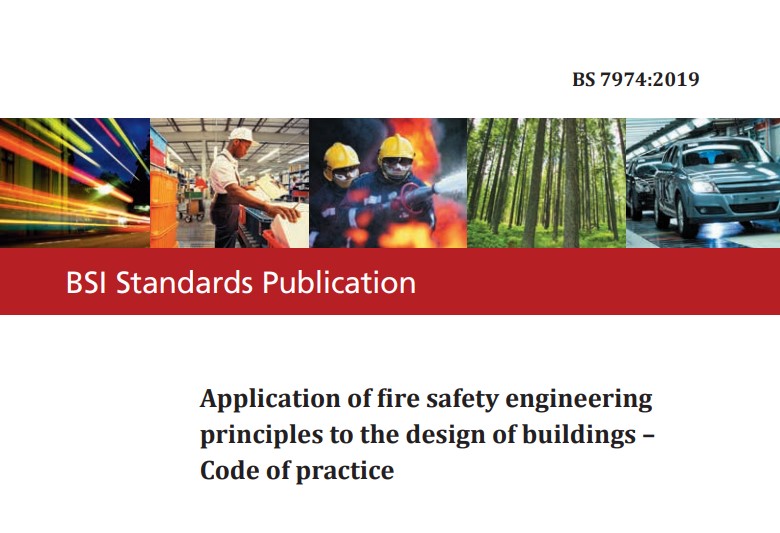BS 7974

|
Contents |
[edit] Introduction
The British Standards Institution (BSI) is the UK National Standards Body (NSB). It publishes standards and provides a range of books, self-assessment tools, conferences and training services. It also represents UK economic and social interests in European and international standards organisations.
BS 7974 Application of fire safety engineering principles to the design of buildings. Code of practice is aimed at fire safety engineers (FSE) and practitioners, and is also intended for:
- Members of the fire and rescue service.
- Structural engineers.
- Architects.
- Government agencies.
- Regulators
- Related industries such as insurers and systems engineers.
BS 7974 was originally released in 2001, with additional updates in 2002, 2003 and 2012. In 2016, however, a 2019 update was the first complete revision since the initial publication of the standard.
[edit] Published documents
Due to the number of published documents (PDs) associated with BS 7974, the complete standard is available as a suite of documents, which includes:
- PD 7974-1 Initiation and development of fire within the enclosure of origin.
- PD 7974-2 Spread of smoke and toxic gases within and beyond the enclosure of origin.
- PD 7974-3 Structural response and fire spread beyond the enclosure of origin.
- PD 7974-4 Detection of fire and activation of fire protection systems. NOTE: This document is no longer maintained since it has been incorporated into other documents, but it is referred to as part of the PD 7974 series for the sake of completeness.
- PD 7974-5 Fire and rescue service intervention.
- PD 7974-6 Occupant evacuation, behaviour and condition.
- PD 7974-7 Probabilistic risk assessment.
The practices included within the standard are applicable to all types of new construction and existing buildings. It is based on an approach to fire safety that focusses on the protection of people and property while showing sensitivity to the environment.
[edit] Qualitative design review
This analytical process is based on the concept of qualitative design review (QDR), which is a technique that allows fire safety engineers to consider the possible ways a fire hazard might arise and establish a range of strategies to maintain the risk at an acceptable level.
The process is broken down into three stages:
- Initial review. Objectives are defined, criteria are established and solutions are proposed.
- Analysis: Evaluations are made of solutions identified in the initial review.
- Assessment: The results of the analysis are measured against the criteria in the initial review.
[edit] Related articles on Designing Buildings Wiki
- Addressing building failures: Grenfell Tower and Edinburgh schools.
- British Standards Institution BSI.
- BS 9999: Code of practice for fire safety in the design, management and use of buildings.
- BS EN 13501-1
- Fire engineered building.
- Fire in buildings.
- Overview of automatic sprinkler system design and operation
- Qualitative design review.
- The role of codes, standards and approvals in delivering fire safety.
[edit] External resources
- BSI, BS 7974:2019.
Featured articles and news
How big is the problem and what can we do to mitigate the effects?
Overheating guidance and tools for building designers
A number of cool guides to help with the heat.
The UK's Modern Industrial Strategy: A 10 year plan
Previous consultation criticism, current key elements and general support with some persisting reservations.
Building Safety Regulator reforms
New roles, new staff and a new fast track service pave the way for a single construction regulator.
Architectural Technologist CPDs and Communications
CIAT CPD… and how you can do it!
Cooling centres and cool spaces
Managing extreme heat in cities by directing the public to places for heat stress relief and water sources.
Winter gardens: A brief history and warm variations
Extending the season with glass in different forms and terms.
Restoring Great Yarmouth's Winter Gardens
Transforming one of the least sustainable constructions imaginable.
Construction Skills Mission Board launch sector drive
Newly formed government and industry collaboration set strategy for recruiting an additional 100,000 construction workers a year.
New Architects Code comes into effect in September 2025
ARB Architects Code of Conduct and Practice available with ongoing consultation regarding guidance.
Welsh Skills Body (Medr) launches ambitious plan
The new skills body brings together funding and regulation of tertiary education and research for the devolved nation.
Paul Gandy FCIOB announced as next CIOB President
Former Tilbury Douglas CEO takes helm.
UK Infrastructure: A 10 Year Strategy. In brief with reactions
With the National Infrastructure and Service Transformation Authority (NISTA).
Ebenezer Howard: inventor of the garden city. Book review.
The Grenfell Tower fire, eight years on
A time to pause and reflect as Dubai tower block fire reported just before anniversary.
Airtightness Topic Guide BSRIA TG 27/2025
Explaining the basics of airtightness, what it is, why it's important, when it's required and how it's carried out.
Construction contract awards hit lowest point of 2025
Plummeting for second consecutive month, intensifying concerns for housing and infrastructure goals.
Understanding Mental Health in the Built Environment 2025
Examining the state of mental health in construction, shedding light on levels of stress, anxiety and depression.























